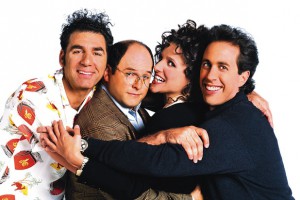Frustrated that no one listens to you, and your super entertaining and enlightening live streams? You only have 5 subscribers to your podcast, and suspect they might all be your Mom with different accounts? Relax. Nobody liked Seinfeld at first, either.
There’s a really interesting article from The Wrap that’s all about the show Seinfeld and it’s rise from obscurity to absurdity, from unknown to best loved. And it’s about what the TV environment was like then, back in 1989 when we rode in horse drawn carriages, wore straw hats, and danced the Charleston. The article is from 1989, but there’s gold there, Jerry, gold.
In “The Seinfeld Chronicles” debut season, in 1989, it was number 14 in popularity. “In 1989, if you forgot to watch or tape “The Seinfeld Chronicles” on your VCR (a small box that constantly flashed 12:00 a.m.), you had to hear about it at work, at the water cooler, which was a liquefied predecessor of Twitter.” Aside from downright magical prose like that, this article shows you some really interesting things.
- Barely anyone watches TV now comparatively. Viewers are spread out all over the place, and you could have a shot at them. With persistence and effort you have a shot at being the most popular content producer on a given channel.
- Another good thing to learn here – you don’t put out one episode and get super popular. You have to be on air regularly and have your story and characters, or message develop over time. Remember the first episodes of Seinfeld? They weren’t exactly great. People didn’t watch. The story needed to develop.
The cure for your stink
The same rings true for our modern times of jet packs, colonies on the Moon and food of many colors that comes in geometrical shapes. You’re not going to put out one show, of whatever type of show you do, and be hugely popular. You’ll likely stink on ice and only your best friends will tune in. Over time you’ll hone your craft. Over time people will come to expect the type of podcast or vidcast or streaming video you do, at a certain time, for a certain length of time. They’ll trust the quality of your work, and look forward to it, and promote it.
I spoke to Chris Barrows, the host of Why I Social, a podcast featuring interviews with people in the trenches of social media, on the subject of influence, consistently producing, and listening to your audience.
Hey Chris – thanks for having the interview mic turned around so you can shed some light on how influence comes with time, consistency and honing your craft. I just have a few questions for you.
How would you describe the increase in listeners to WhyISocial? Did you start out with tons of listeners? Is it a steady, linear progression, or more like a hockey stick looking increase?
1. Aside from a very strange jump in which I had a big jump in downloads for three or four months – it’s been a consistent, yet targeted growth. Early on, I was barely getting 100 downloads per episode (the average is around 170 or so according to Libsyn) and that’s obviously changed since I started.
Here’s an #InfluencerMarketing strategy: Treat people with respect. Earn their loyalty. Empower them to talk about you.
— Martin Lieberman (@martinlieberman) August 19, 2016
We know the recipe for influence – put into practical terms, you grow your community, relationships and trust by consistently being there, adding value, getting better all the time, whether people are coming to the smelly basement bar you play in Liverpool or Hamburg or not (Beatles reference for those of you who haven’t had your coffee, or those of you too young to appreciate the classics). Final nugget from that article,
For the full 1989-90 season, the 6.8 rating for “The Walking Dead” would place it in a tie for No. 54, behind “Perfect Strangers.”




